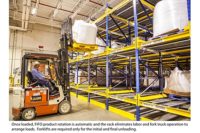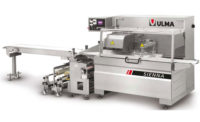Pallet Flow, Pushback Racks Put the Power of Gravity to Work
For maximum pallet rack use in a minimum footprint along with inventory management capability, a warehouse pallet flow storage system can be the answer.

Dynamic storage systems, such as pallet flow and pushback rack, put the power of gravity to work. Using an arrangement of inclined rails in a rack-supported structure to control product-pallet movement and access, both make labor and inventory access more efficient by using the least amount of warehouse space. They also share many cost benefits—from offsetting the need for new construction to reducing operational expenditures for forklifts, labor and energy.
structure to control product-pallet movement and access, both make labor and inventory access more efficient by using the least amount of warehouse space. They also share many cost benefits—from offsetting the need for new construction to reducing operational expenditures for forklifts, labor and energy.
Yet, for all these similarities, pallet flow and pushback rack storage systems have very different designs, as they are developed for very different applications. Here is what industry professionals need to know about pallet flow and pushback rack storage systems.
Pallet flow storage
For maximum pallet rack use in a minimum footprint along with inventory management capability, a warehouse pallet flow storage system can be the answer. Once loaded, “first-in, first-out” (FIFO) product rotation is automatic, and the rack eliminates labor and forklift operation to arrange loads. Forklifts are required only for the initial loading and final unloading. This is more labor efficient than a traditional selective rack, where pallets are stored just one deep, because immediate access to every pallet is necessary and a forklift is required for all pallet movement and arrangement. Compared to selective rack, which requires multiple aisles and offers low storage density, pallet flow storage can reduce aisle space by 75% and store up to 100% more product.
A pallet flow storage system consists of three main elements—rack structure, flow rails and the pallet. The flow rails are set within the rack structure at a slight incline, which allows pallet loads placed on one end of the rack to move, by gravity, to the other end of the rack. Wheels or rollers are mounted within the rails along with self-energizing brakes to control pallet speed. As a pallet is unloaded at the front end, the next pallet in line moves forward.
“Flow storage systems can be expected to flow a wide range of product—anything from small cartons weighing 5 pounds to pallet or container loads weighing 4,000 pounds,” says Dick DeFoe, national accounts manager for flow and pushback at Steel King, a Stevens Point, Wis.-based manufacturer of flow storage, pushback rack and pallet rack systems.
Flow rails are either wheel- or roller-based depending on a number of factors such as pallet type and product weight, according to DeFoe. In general, a wheel-based rail conveyor is used with pallets that have a wider, stable base that will not catch or hang up as it moves over the wheel surface.
Yet the pallet—how well the pallet sits, moves and stops on the flow lane—is the key difference between a smooth-flowing system and one that does not perform up to expectations.
“The pallet type determines what flow type of dynamic flow rail is used, how the overall system is designed and whether the system will work properly at all,” says DeFoe.
In many industries, pallets are often used, discarded and chosen on cost alone, but the pallet is critical. Poorly constructed or maintained wooden pallets may hinder product flow. Plastic pallets, though increasingly popular, are not well suited to wheel-based conveyors in design and construction.
“For best flow storage results, if the pallet types vary from the standard GMA pallet developed by the grocery industry, it’s best to consult with an expert to determine the best system for your pallet types,” says DeFoe, whose company designs flow systems for a variety of pallet types, including wooden, plastic, skids, metal containers and shipping racks.
“Steel King’s flow storage system was the only system that allowed flow of the plastic pallets we needed,” says Tim Pancake, project engineer for C&M Fine Pack, Irvine, Calif. “The unmodified system also worked well for loads stored on wooden pallets that another customer required.”
Pushback rack storage
Pushback rack offers dense storage and up to 400% more pallet access (also known as selectivity) than drive-in racks, in which forklifts drive inside special parallel rack structures to access pallets stored two or more deep. Pushback rack can also offer up to 90% more product storage than selective rack, while offering good pallet access.
In a dynamic pushback rack system, pallets are stored behind each other in a series of nested carts riding on inclined rails, and are loaded from the same side of the system, minimizing the need for aisles and maximizing storage space. As a forklift places each pallet on a nested cart riding on the inclined rails and pushes it back, previous pallets are pushed back on their carts, exposing the next cart for loading. When a forklift removes a pallet, gravity causes the remaining pallet carts to slide down the inclined rail, positioning the front-most pallet to be easily picked up by forklift. Unlike static, single-pallet deep selective rack, a dynamic pushback rack system allows storage of pallets 2-5 deep while providing easy access to a variety of different SKUs.
A common use for the pushback system is frozen food storage. Because freezer space is so expensive to build and maintain, storage density is a must. For example, a 20,000-pallet pushback racking system was installed inside the freezer of a major ice cream manufacturer, and another was installed inside a cooler of the dairy division of a large Midwestern food conglomerate. Both of these companies were seeking to maximize every possible square inch of storage space, and these systems were the answer.
But, any enterprise, particularly those in distribution or manufacturing with a lower number of SKUs in high rotation, can benefit from pushback pallet racking. Those interested in a pushback rack system, however, may do well to consider a company that can be a single-source solution.
“A company that can manufacture the racks, the pushback rail system and perform the installation can be the sole source of responsibility,” says DeFoe. “Otherwise the dealer has to deal with one source for the racks, another source for the pushback system and maybe a third for the installation. If something doesn’t work right, one source can blame another, and it can get complicated.”
Since every system is made to order, all spatial and weight circumstances are taken into consideration. In addition to standard pallet sizes, pushback pallet racking can be designed to accommodate non-standard pallets such as plastic pallets, skids and special metal containers, and can be built with a weight capacity of up to 3,000 pounds per pallet.
To quickly get forklift operators up to speed on the key differences between traditional static loads and the dynamic pushback system while avoiding forklift damage or pallet rack damage, warehouse managers can rely on the Pushback System Safe Operating Procedures User Handbook.
“Using the safety manual should cut forklift operators’ learning curve in half, while helping them operate more safely and productively,” says John Calkins, vice president of sales for Meyer Material Handling, an Indianapolis, Ind.-based reseller and installer of material handling and storage systems. “It covers the three main points that every forklift driver must master to get the most out of a pushback system—controlling the load when it comes forward, properly positioning pallets and avoiding ‘cross stacking,’ or the placing of pallets on multiple carts.”
By employing a pushback pallet rack system and principles covered in the safety manual, Meyer Material Handling helped one wire manufacturing customer implement a warehouse system that essentially doubled storage in about 60% less space, compared to a previous selective rack system, according to Calkins.
“That lowered long-term overhead costs, while enabling expansion possibilities,” says Calkins. “Many pushback systems can generate ROI in just over two years.”
Although pallet flow and pushback rack storage systems offer compelling benefits individually, combining rack types to better use vertical space can further improve storage density.
“For instance, while sharing a common pick aisle, pallet flow can be used at the bottom of a rack structure with pushback at the top, adding an additional 2- to 3-pallet capacity per level,” adds DeFoe.
Looking for a reprint of this article?
From high-res PDFs to custom plaques, order your copy today!








